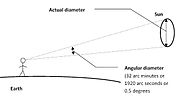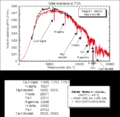Apparent magnitude (m) is a measure of the brightness of a star or other astronomical object. An object's apparent magnitude depends on its intrinsic luminosity...
65 KB (4,801 words) - 07:27, 4 June 2024
List of brightest stars (redirect from Stars by apparent magnitude)
stars arranged by their apparent magnitude – their brightness as observed from Earth. It includes all stars brighter than magnitude +2.50 in visible light...
36 KB (1,309 words) - 21:23, 24 May 2024
astronomical magnitude scale. An object's absolute magnitude is defined to be equal to the apparent magnitude that the object would have if it were viewed from...
49 KB (5,751 words) - 22:31, 5 November 2023
of its magnitude, with the brightest objects reaching negative values. Astronomers use two different definitions of magnitude: apparent magnitude and absolute...
26 KB (2,954 words) - 06:11, 28 May 2024
calibrated apparent brightness of a celestial object Instrumental magnitude, the uncalibrated apparent magnitude of a celestial object Limiting magnitude, the...
2 KB (281 words) - 02:11, 1 October 2023
Hertzsprung–Russell diagram (redirect from Color-magnitude diagram)
him to estimate their absolute magnitude. In 1910 Hans Oswald Rosenberg published a diagram plotting the apparent magnitude of stars in the Pleiades cluster...
23 KB (2,771 words) - 20:37, 11 May 2024
Luminosity (section Relationship to magnitude)
light along the path from object to observer. Apparent magnitude is a logarithmic measure of apparent brightness. The distance determined by luminosity...
24 KB (3,038 words) - 15:48, 7 April 2024
First-magnitude stars are the brightest stars in the night sky, with apparent magnitudes lower (i.e. brighter) than +1.50. Hipparchus, in the 1st century...
16 KB (817 words) - 20:44, 27 March 2024
brighter at its peak than any other star in the night sky, with an apparent magnitude of −2.5. It was visible during the day for over three weeks. Records...
16 KB (1,675 words) - 13:02, 20 May 2024
Photometry (astronomy) (redirect from Photoelectric magnitude)
known intensity and colour, photometers can measure the brightness or apparent magnitude of celestial objects. The methods used to perform photometry depend...
29 KB (3,178 words) - 15:04, 30 April 2024
be a synonym for a fireball, sometimes specific to those with an apparent magnitude of −4 or brighter. The word bolide (/ˈboʊlaɪd/; from Italian via Latin...
7 KB (688 words) - 21:58, 5 June 2024
Apparent may refer to: Apparent magnitude, a measure of brightness of a celestial body as seen by an observer on Earth Apparent places, the actual coordinates...
559 bytes (113 words) - 06:16, 16 April 2023
Angular diameter (redirect from Apparent size)
The angular diameter, angular size, apparent diameter, or apparent size is an angular distance describing how large a sphere or circle appears from a given...
24 KB (1,767 words) - 03:31, 20 April 2024
Sirius (section Apparent third star)
Canis Majoris, and abbreviated α CMa or Alpha CMa. With a visual apparent magnitude of −1.46, Sirius is almost twice as bright as Canopus, the next brightest...
96 KB (10,050 words) - 08:16, 26 May 2024
The comet passed perihelion on 17 September 2023 and reached an apparent magnitude of about 2.5. Japanese amateur astronomer Hideo Nishimura discovered...
14 KB (964 words) - 08:42, 3 April 2024
such as Cetus the whale, Pisces the fish, and Eridanus the river. At apparent magnitude 2.9, Beta Aquarii is the brightest star in the constellation. Aquarius...
36 KB (3,975 words) - 04:48, 28 April 2024
Solar constant (section Apparent magnitude)
with the apparent magnitude of the Sun which is −26.8. The solar constant and the magnitude of the Sun are two methods of describing the apparent brightness...
13 KB (1,763 words) - 18:51, 30 April 2024
the Sun's diameter. Despite its proximity, the star has a dim apparent visual magnitude of +9.5 and is invisible to the unaided eye; it is much brighter...
53 KB (5,072 words) - 16:46, 3 May 2024
Orionis, forms Orion's head, and is a multiple star with a combined apparent magnitude of 3.33. Its name means the "shining one". Orion's Belt or The Belt...
46 KB (5,178 words) - 15:15, 6 June 2024
forward scattering. The comet by January 2024 had brightened to an apparent magnitude of 13.6 and according to Bob King was visible through 15-inch telescopes...
15 KB (1,262 words) - 20:10, 6 June 2024
International Astronomical Union, this makes it the brightest star by apparent magnitude to remain without an IAU approved name. The γ Velorum system includes...
18 KB (1,508 words) - 20:30, 25 May 2024
eye, these two main components appear to be a single star with an apparent magnitude of −0.27 . It is the brightest star in the constellation and the third-brightest...
119 KB (11,265 words) - 10:44, 5 June 2024
constellation Boötes. Located only 37 light years away, it has an apparent magnitude of -0.04. It is the brightest star in the Northern Hemisphere and...
20 KB (2,242 words) - 03:21, 8 October 2023
= 1.3+0.8 −0.4 ly ^ 8.8 apparent magnitude − 5 × (log10(700+450 −200 pc distance / 10 pc)) = −0.2+0.7 −1.8 absolute magnitude ^ Specifically in the north...
16 KB (1,564 words) - 23:28, 20 February 2024
than TRAPPIST-1, and its size is similar to that of Jupiter. Its apparent magnitude is estimated at 17.8, which is too faint to be seen by the naked eye...
11 KB (999 words) - 16:02, 4 June 2024
semiregular variable star whose apparent magnitude, varying between +0.0 and +1.6, has the widest range displayed by any first-magnitude star. Betelgeuse is the...
172 KB (18,256 words) - 15:06, 6 June 2024
within the Small Sagittarius Star Cloud, a white supergiant with an apparent magnitude of 6.05. This star is an Alpha-2 Canum Venaticorum variable, showing...
7 KB (667 words) - 18:25, 29 December 2023
become an orange giant with an apparent magnitude of 2.08, only slightly fainter than Polaris. Kochab and 3rd-magnitude Gamma Ursae Minoris have been called...
52 KB (5,853 words) - 00:25, 25 May 2024
(232 million km) on 2 June 2024. The comet is expected to brighten to about apparent magnitude 4.5. The comet nucleus is estimated to be around 30 km in diameter...
32 KB (2,934 words) - 16:32, 3 June 2024

























